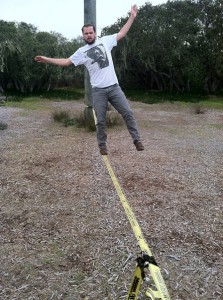 College sports have come a long way from throwing a Frisbee around in the quad with your friend named Brad. A college student’s schedule is, for the most part, very flexible and what better way to fill that time with some healthy outdoor activities?
College sports have come a long way from throwing a Frisbee around in the quad with your friend named Brad. A college student’s schedule is, for the most part, very flexible and what better way to fill that time with some healthy outdoor activities?
Quidditch is one professionalized collegiate sport that is on the rise, figuratively. This sport originated in J.K. Rowling’s wizarding world in the Harry Potter series but has been reinvented for muggles (non-wizards). The first with broomsticks took place in Middlebury, Vermont back in 2007 and since then the International Quidditch Association (or IQA) has grown to 78 teams nationwide.
Quidditch is played on a grass field with three Goal Hoops on either end. The rules of the game are quite simple: each player must hold a broom between their legs at all times without the use of any artificial attachment. The game begins with one red ball thrown to the opposing team. If a player holding said ball is hit, they much drop the ball and run to their Goal Hoops before returning to play. There is one white ball that is to be advanced down the field through running with the ball or passing. There is one tennis ball used as “The Snitch” that is placed in a long sock and tucked into the back of the Snitch Runner’s shorts. If any person catches designated Snitch runner, the game is ended and the points are added up. Whichever team catches the snitch adds 50 points to their overall score.
If wizard games aren’t for you, outdoor recreation from backpacking and hiking to rock climbing (both indoor and outdoor) have been popular among collegians. Many colleges embrace the environment around their campuses through outdoor clubs for students who are interested but weary of starting outdoor sports such as kayaking, canoeing, hiking, camping and such.
Slacklining is another sport that is on the rise. If you have seen the Super Bowl half time show, you would have seen Andy Lewis’s incredible stunts. Although not a professional game in the collegiate world, this hobby has been adopted mostly by the American West Coast. The sport originated in the Yosemite Valley in California. This is a very minimalistic activity as the only equipment needed is the slack line itself. Slacklining is a test of balance. A slackline, usually $40-$70, is stretched across two trees or poles. The line’s tension can vary and be adjusted to the user. A person can start by simply balancing on the line with both feet, then maybe one foot or try to walk across the line. More advanced slackliners practice jumping or yoga moves on the line.
Disc golf is another sport that may soon become an NCAA sport. Disc golf is exactly what it is named: it is the game of golf but instead of using a club and golf ball, a person is throwing a Frisbee. There is a soaring number of disc golf clubs that have been forming on college campuses. In 2010, 26 teams participated in a tournament in South Carolina. Other states who are known in the disc golf realm are Alabama, Arkansas, California, Florida, Georgia, Indiana, Kansas, Mississippi, Oregon, Pennsylvania, Tennessee, Texas, Virginia and Illinois.
So why can’t college kids just go to the court and shoot a basketball around or participate in traditional sports? While standard sports are still very popular in college, these other sports can play out fantasies as in Quidditch; they can be practiced in small groups of friends; and they get you moving in a way that you might never have before. It is proven that workouts are more efficient when disguised through fun activities. So go out and play!
-TravelBug
I’m reading Pocket Guide to APA Style
